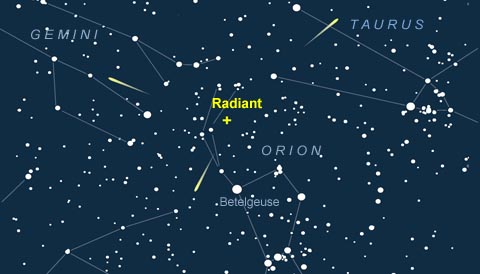Astronomy - Keep Watch for November’s Orionid Meteors
Although relatively obscure, this modest display is the strongest meteor shower in late November. Moonless skies make them easier to pick out.
Most of us can tick off the Perseids, Geminids, Leonids, and maybe a couple of other major annual meteor showers. But did you know that the International Astronomical Union recognizes more than 100 different well-established meteor showers throughout the year — with dozens more under investigation? Who has time to observe all of those!
You might think that late November is one of those "in-between" spells when not much is happening, meteor-wise. However, the International Meteor Organization (a volunteer group of hundreds of observers) has recently called attention to a lesser-known shower called the November Orionids.

The radiant of the November Orionid meteor shower is situated above Betelgeuse in the upraised arm of Orion, the Hunter.
Source: International Meteor Organization
Source: International Meteor Organization
According to the IMO, the November Orionids are detected regularly in video data, and they're seen more often than are several other minor showers that crop up this time of year. It's a different stream than the somewhat stronger Orionids seen in late October, but they both involve dust particles shed by Comet 1P/Halley.
The shower lasts for a couple of weeks centered on November 28th, around which time you might spot a few of these per hour. The radiant is in northern Orion, situated in the Hunter's upraised arm and club a few degrees north of Betelgeuse. Don't confuse a November Orionid meteor, which zips into our atmosphere at 41 km (25 miles) per second, with the slower Northern Taurids that radiate from a point farther west in the Bull's horns.
The Moon will be within a day or two of new, thus not an issue, and Orion should be well up by about 9 p.m. local time and culminates about 4 hours later. So if you happen to spot one or two of the November Orionids (or if you go looking and see nothing), post a comment below to help us compile some ground truth about this modest display of "shooting stars."
No comments:
Post a Comment